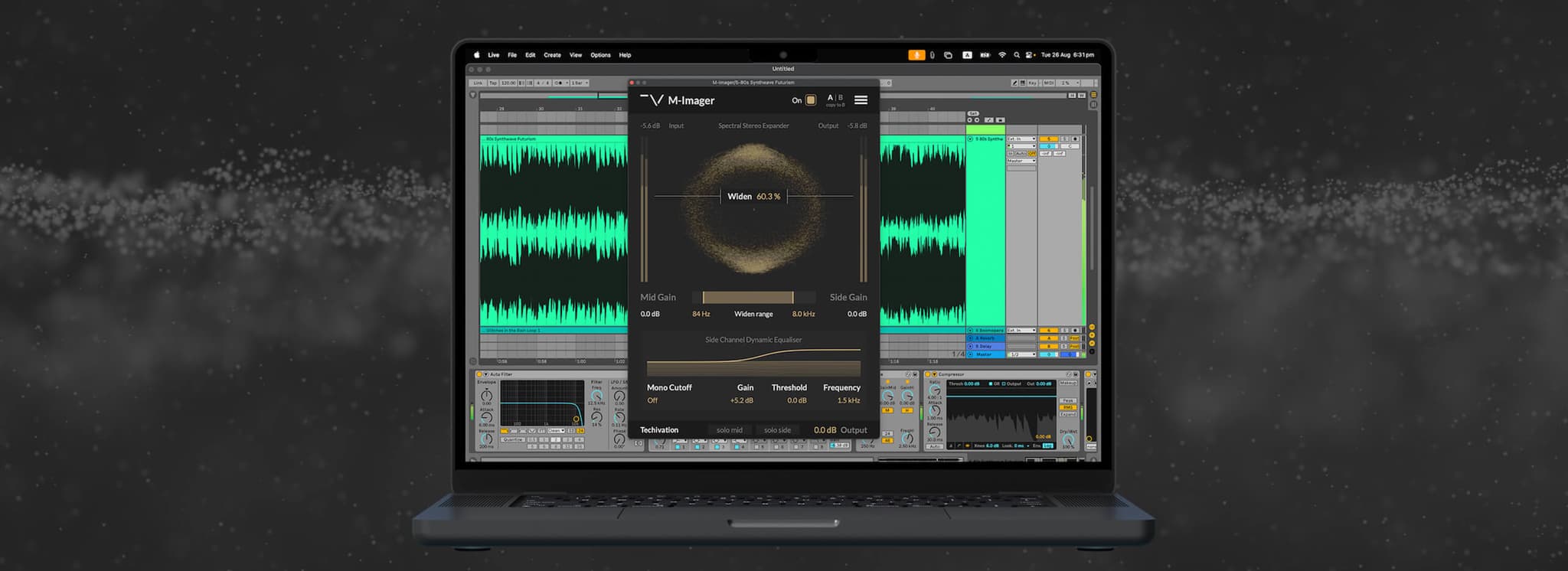How to eliminate boxiness and muddiness in your mixes using M-Clarity

Introduction
We’ve all had those moments in a mix where things start to feel dull and unclear after a point. Instead of reaching for the high shelf EQ to try and bring some sparkle back into your mix, you first need to take a look lower down the frequency range. In this article, we will discuss muddy and boxy mixes, how you can identify them, and how to fix them. Spoiler alert…it’s really easy to fix all these issues with our Techivation M-Clarity plugin, but we will get to that.
Muddy Boxes?
Have you ever had someone call your mix “muddy” or “boxy”? Well, it doesn’t feel great, not that anyone has ever said that to me… Anyway, as you build a track, muddiness and boxiness can be quite a common issue. These words are very subjective, but it’s generally agreed that muddiness can be found around 200Hz and causes a murky, dull and indistinct sound in your mix, whereas boxiness can be described as imparting a hollow, confined or “boxy” quality to your sound, found in the 200-500Hz frequency range.
You might find individual elements have the same unclear and muffled quality, and if you have enough of those elements with these issues, that is one of the quickest ways to a muddy mix. Here is an isolated example of a boxy sound, hear how the frequencies are building up in the lower mids, and preventing you from hearing the details in the track.
What causes Muddiness and Boxiness?
There are a few reasons for muddy and boxy tracks. A big culprit is poor recording quality, whether microphone choice, microphone placement or the acoustics of the room. This is why it is key to train your critical listening and try to capture everything correctly at source, it’ll save you the headache down the line!
Another cause of muddiness and boxiness can be to do with your mixing workflow, by overusing certain plugins you can add phase issues as well as cluttering the mix with reverbs and time-based effects.
It could also be simply having too much going on in that area of your mix, which is a difficult one, because a lot of the important elements of a track can be found in the 200-500Hz frequency range, such as kick, snare, bass guitar, vocals etc. So short of re-arranging the entire track how do we fix that?
The old way to fix it
So we’ve already established that the cause is down to the frequencies in the audio, so naturally the solution would be to EQ it, right? That is one way of doing it, reducing the presence of the problematic frequencies on the tracks that are causing issues. This, however, is not hugely accurate, as changes in the notes (something that tends to happen in music…) will result in the EQ curve not attenuating the correct frequencies anymore unless you have a very wide band.
Alternatively, you could use Dynamic EQs or multiband compressors. These tools will give you higher levels of accuracy, by only reducing the frequencies when they are present in the signal. However, these plugins can often be a bit of a pain to configure, with unhelpfully complicated windows and tons of settings that all need to be dialled in correctly to have even a hope of improving your sound. These plugins could even degrade your sound quality by creating phasing issues. If only there was something better…
The new way to fix it
This is where the Techivation M-Clarity plugin comes in! This plugin has been specifically designed to suppress any sound's unwanted muddy, boxy, and harsh frequencies and resonances. It uses a unique spectral shaping algorithm to accurately detect and remove the troublesome frequencies, much better than relying on wideband EQ, and it’s incredibly simple to use, so much better than a multiband compressor or dynamic EQ.
Listen to how the guitar example sounds after having M-Clarity put on it, targeting the low mid frequencies. You can hear how it removes the resonance and (as the name suggests) boosts clarity overall in the sound, and to top it all off, the resulting sound is artefact-free due to the spectral processing.
M-Clarity: Bypassed
Before/After Comparison - Adding Weight to Kick & Snare

By first selecting the frequency range you’d like for M-Clarity to tackle, you then simply need to adjust the Suppression control to adjust how much the targeted frequencies are reduced, along with the intensity and focus controls which affect how hard or gentle M-Clarity goes after any resonant peaks in your signal.
Here is an example of an element causing issues in the context of a mix. Here we have a hip-hop beat, piano and cello, and already the mix is sounding a bit muddy. The piano seems to be the culprit with some resonances in the low mids, however, if we apply an M-Clarity plugin across the mix bus, dialling in the problematic frequencies, you can hear how those frequencies are cleaned up, and overall everything becomes clearer. So you can see that M-Clarity works on individual elements as well as groups if applied over an aux bus.
M-Clarity: Bypassed
Before/After Comparison - Adding Weight to Kick & Snare
Summary
Muddiness and boxiness can be a big source of headaches when mixing, and while every effort should be given to solve the issue at the source, sometimes you need to “fix it in the mix”. Going down that route, why not make it easy on yourself? Give M-Clarity a go and spend the time you would have spent dialling in EQ and multiband settings being creative with your mixes.
If you want to hear more examples of M-Clarity at work then head to the product page. You can also try it out for 14 days for free, so go and give it a go and say goodbye to muddy and boxy mixes!
Written By Harry Lewis
Share this Article
Featured in this post



![[Video] New Update Released: Techivation M-Exciter](/_next/image?url=https%3A%2F%2Fstatic.techivation.com%2Fuploads%2FM-Exciter%2520New%2520Update.jpg&w=2048&q=75&dpl=dpl_8MtNB4V4GNBGc35CzAz4qvG2ozTf)
